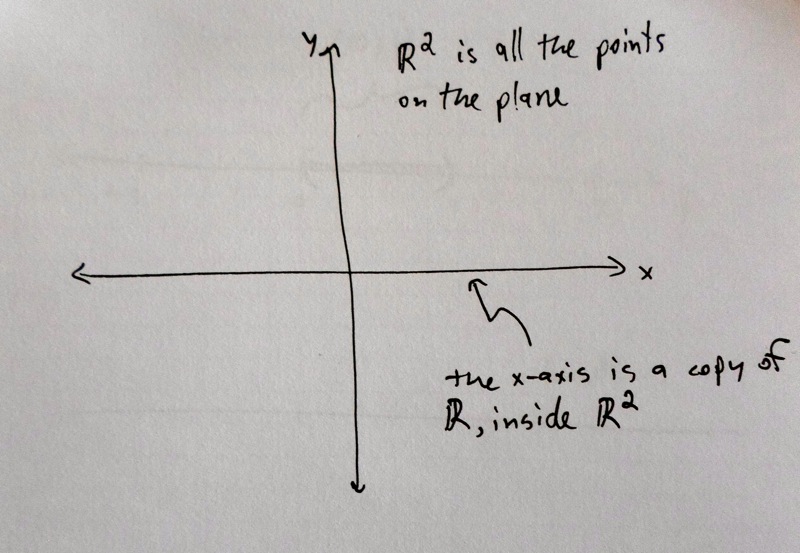Remember that \(\mathbb{R}\) is the continuous one-dimensional real line, and \(\mathbb{R}^2\) is the continuous two-dimensional plane. We can imagine a copy of \(\mathbb{R}\) sitting inside \(\mathbb{R}^2\), as the \(x\)-axis of a coordinate system. The elements of \(\mathbb{R}^2\) are of the form \([x, y]\), where \(x\) and \(y\) are real numbers. Then the \(x\)-axis is all the points of the form \([x, 0]\), where \(x\) is any real number. (The \(x\)-axis is exactly the points where the \(y\)-coordinate is zero.)

So we can construct a one-to-one correspondence between \(\mathbb{R}\) and the \(x\)-axis of the plane. Every real number \(x\) gets assigned to \([x, 0]\). This clearly hits every point on the \(x\)-axis once and only once. Since the \(x\)-axis is a subset of the whole plane \(\mathbb{R}^2\), we can conclude that \(|\mathbb{R}| ≤ |\mathbb{R}^2|\).
So far this isn't so surprising. But next we'll explain that \(|\mathbb{R}^2| ≤ |\mathbb{R}|\).
To do this carefully, we have to line up the digits of \(x\) and \(y\) so they have the same number of digits, and their decimal points match. This isn't a problem, since we can always add zeros to the left and right as needed. So we think of \([13, 200]\) as \([013.0, 200.0]\), and this gets assigned to \(021030\).
This rule assigns every element of \(\mathbb{R}^2\) to an element of \(\mathbb{R}\). It turns out that it doesn't actually hit every element of \(\mathbb{R}\) (read the In-Depth explanation to see why).
But the good news is that every element of \(\mathbb{R}\) it does hit, it only hits once. Another way of thinking of this is that we can undo the rule. From a real number like \(0.121212…\), it's possible to recover the point \([0.111…, 0.222…]\) that hit it. Just unweave the real number into two.
